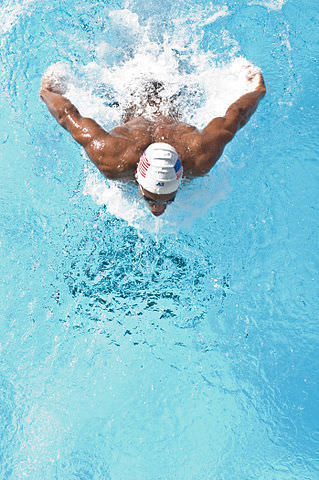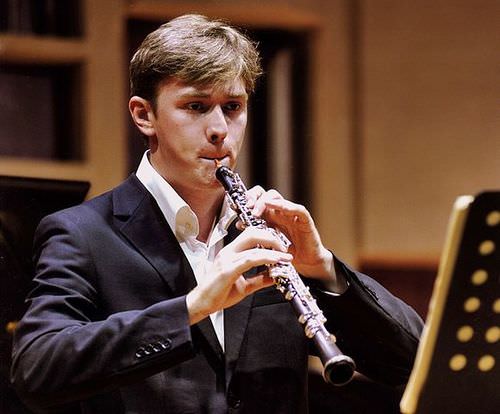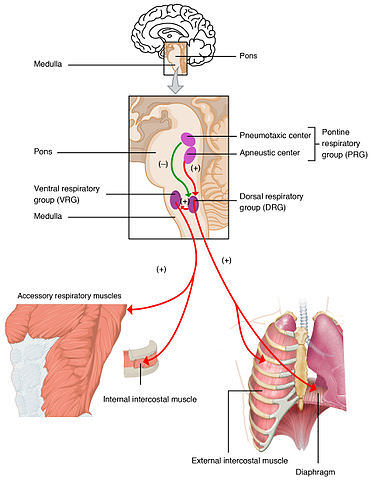15.3 呼吸
章节大纲
-
Doing the ‘Fly
::做"飞"The swimmer in this photo is doing the butterfly stroke , a swimming style that requires the swimmer to carefully control his breathing so it is coordinated with his swimming movements . Breathing is the process of moving air into and out of the lungs , which are the organs in which gas exchange takes place between the atmosphere and the body. Breathing is also called ventilation , and it is one of two parts of the life-sustaining process of respiration . The other part is gas exchange. Before you can understand how breathing is controlled, you need to know how breathing occurs.
::这张照片中的游泳者正在做蝴蝶中风,这种游泳风格要求游泳者仔细控制他的呼吸,以便与他的游泳运动相协调。呼吸是将空气流进和流出肺的过程,肺部是大气和身体之间发生气体交换的器官。呼吸也叫通风,是维持生命呼吸过程的两个部分之一。另一部分是气体交换。在你了解如何控制呼吸之前,你需要知道呼吸是如何发生的。How Breathing Occurs
::如何呼吸氧化物Breathing is a two-step process that includes drawing air into the lungs, or inhaling , and letting air out of the lungs, or exhaling. Both processes are illustrated in the figure .
::呼吸是一个两步过程,包括将空气引入肺部,或吸入,或将空气从肺部释放出来,或呼气。 图中说明了这两个过程。Breathing depends mainly on repeated contractions of the diaphragm.
::呼吸主要取决于隔膜的反复收缩。Inhaling
::吸入Inhaling is an active process that results mainly from contraction of a muscle called the diaphragm , shown in the figure above. The diaphragm is a large, dome-shaped muscle below the lungs that separates the thoracic (chest) and abdominal cavities. When the diaphragm contracts, the thoracic cavity expands, and the contents of the abdomen are pushed downward. Other — such as external intercostal muscles between the ribs — also contribute to the process of inhalation, especially when inhalation is forced, as when taking a deep breath. These muscles help increase thoracic volume by expanding the ribs outward. With the chest expanded, there is lower air pressure inside the lungs than outside the body, so outside air flows into the lungs via the respiratory tract .
::吸入是一个活性过程,主要来自上文图所示称为隔膜的肌肉收缩,隔膜是肺部下方一个巨大的圆形肌肉,将胸腔和腹腔分离开来,当隔膜结合时,胸腔会膨胀,腹部的内脏会往下推。其他的,如肋骨之间的外部内脏肌肉,也有助于吸入过程,特别是当吸入时,如深呼吸时。这些肌肉有助于通过将肋骨向外伸展来增加胸腔的体积。随着胸部的扩大,肺部的空气压力比身体外部低,因此外部空气通过呼吸道进入肺部。Exhaling
::呼气Exhaling involves the opposite series of events. The diaphragm relaxes, so it moves upward and decreases the volume of the thorax. Air pressure inside the lungs increases, so it is higher than the air pressure outside the lungs. Exhaling, unlike inhaling, is typically a passive process that occurs mainly due to the elasticity of the lungs. With the change in air pressure, the lungs contract to their pre-inflated size, forcing out the air they contain in the process. Air flows out of the lungs, similar to the way air rushes out of a balloon when it is released. If exhalation is forced, internal intercostal and abdominal muscles may help move the air out of the lungs.
::呼吸与吸入不同,通常是一种被动过程,主要由于肺部的弹性。随着气压的变化,肺部会缩缩缩到预膨胀的大小,迫使肺部空气流出。气流从肺中流出,与气球释放时的气压一样。如果呼吸是被迫的,内部成本间和腹部肌肉可以帮助将肺部的空气排出。Control of Breathing
::呼吸管控制Breathing is one of the few vital bodily functions that can be controlled consciously, as well as unconsciously. Think about using your breath to blow up a balloon. You take a long, deep breath, and then you exhale the air as forcibly as you can into the balloon. Both the inhalation and exhalation are consciously controlled.
::呼吸是少数可以有意识和无意识地控制的重要身体功能之一。 考虑用呼吸来吹气球。 您要用长长的深呼吸, 然后尽量将空气吸进气球中。 吸入和呼气都是有意识地控制的。Conscious Control of Breathing
::呼吸自觉控制You can control your breathing by holding your breath, slowing your breathing, or hyperventilating, which is breathing more quickly and shallowly than necessary. You can also exhale or inhale more forcefully or deeply than usual. Conscious control of breathing is common in many activities besides blowing up balloons, including swimming, speech training, singing, playing many different musical instruments (see photo ), and doing yoga, to name just a few.
::你可以通过屏住呼吸、减慢呼吸或超速呼吸来控制呼吸,呼吸速度和浅浅度超过需要。您也可以比平常更有力或更深的吸气或吸气。除了吹气球之外,对呼吸的自觉控制在很多活动中是常见的,包括游泳、语言训练、唱歌、演奏许多不同的乐器(见照片)和做瑜伽,仅举几个例子。Playing the oboe is hard work. Exhaled air must be forced through a tiny opening between two very small wooden reeds.
::吹双簧管是很辛苦的工作。必须迫使呼吸空气穿过两个非常小的木锥之间的一个小孔。There are limits on the conscious control of breathing. For example, it is not possible for a healthy person to voluntarily stop breathing indefinitely. Before long, there is an irrepressible urge to breathe. If you were able to stop breathing for a long enough time, you would lose consciousness. The same thing would happen if you were to hyperventilate for too long. Once you lose consciousness so you can no longer exert conscious control over your breathing, involuntary control of breathing takes over.
::呼吸的自觉控制是有限度的。 例如, 健康的人不可能无限期地停止呼吸。 不久之后, 就会有一种不可抑制的呼吸冲动。 如果您能够长时间停止呼吸, 你就会失去意识。 如果呼吸过度过长, 也会发生同样的情况。 一旦你失去意识, 从而无法对呼吸进行自觉控制, 非自愿的呼吸控制就会被取代。Unconscious Control of Breathing
::呼吸管的无意识控制Unconscious breathing is controlled by respiratory centers in the medulla and pons of the brainstem (see diagram ). The respiratory centers automatically and continuously regulate the rate of breathing based on the body’s needs. These are determined mainly by acidity, or pH. When you , for example, carbon dioxide levels increase in the blood, because of increased by muscle . The carbon dioxide reacts with in the blood to produce carbonic acid, making the blood more acidic, so pH falls. The drop in pH is detected by chemoreceptors in the medulla. Blood levels of oxygen and carbon dioxide, in addition to pH, are also detected by chemoreceptors in major arteries , which send the “data” to the respiratory centers. The latter respond by sending to the diaphragm, “telling” it to contract more quickly so the rate of breathing speeds up. With faster breathing, more carbon dioxide is released into the air from the blood, and blood pH returns to the normal range.
::呼吸由脑激素的呼吸中心控制。呼吸中心自动并持续根据身体需要调节呼吸速度。呼吸中心主要由酸性或pH决定。例如,血液中的二氧化碳水平因肌肉增加而增加。二氧化碳在血液中与血液中反应产生碳酸,使血液酸化更多,pH值下降。pH值下降。在脑震荡中,黑桃感应器检测到pH值下降。氧气和二氧化碳的血液水平,以及pH值,也由主要动脉中的乳房检测到,这些动脉将“数据”发送到呼吸中心。后者通过发送隔膜,“提示”它以更快的速度收缩,从而加速呼吸速度。呼吸速度加快,更多的二氧化碳从血液中释放到空气中,血液中的血液pH值恢复到正常范围。Clusters of cells in the pons and medulla of the brain stem are the respiratory centers of the brain that have involuntary control over breathing.
::脑干骨和中脊的细胞群是大脑的呼吸中心,对呼吸有非自愿控制。The opposite events occur when the level of carbon dioxide in the blood becomes too low and blood pH rises. This may occur with involuntary hyperventilation, which can happen in panic attacks, episodes of severe pain, asthma attacks, and many other situations. When you hyperventilate, you blow off a lot of carbon dioxide, leading to a drop in blood levels of carbon dioxide. The blood becomes more basic (alkaline), causing its pH to rise.
::当血液中的二氧化碳含量太低,而血液pH值上升时,就会发生相反的情况。这种情况可能发生于非自愿的超通风,在恐慌发作、剧烈疼痛、哮喘发作和许多其他情况下可能发生。当呼吸过度时,就会大量释放二氧化碳,导致二氧化碳的血液水平下降。血液变得更加基本(碱性 ) , 导致其pH值上升。Nasal vs. Mouth Breathing
::Nasal诉口腔呼吸Nasal breathing is breathing through the nose rather than the mouth, and it is generally considered to be superior to mouth breathing. The hair-lined nasal passages do a better job of filtering particles out of the air before it moves deeper into the respiratory tract. The nasal passages are also better at warning and moistening the air, so nasal breathing is especially advantageous in the winter when the air is cold and dry. In addition, the smaller diameter of the nasal passages creates greater pressure in the lungs during exhalation. This slows the emptying of the lungs, giving them more time to extract oxygen from the air.
::鼻腔呼吸通过鼻部而不是嘴呼吸,一般认为鼻部呼吸优于口腔呼吸。 毛线鼻孔在进入呼吸道更深处之前,更好地将微粒从空气中过滤出来。 鼻腔呼吸在警告和潮湿空气方面也更好,因此鼻部呼吸在冬天特别有利,因为空气冷干。 此外,鼻部呼吸道的直径较小,在呼吸过程中对肺造成更大的压力。这减缓了肺部的排气速度,让肺部有更多的时间从空气中提取氧气。Feature: Myth vs. Reality
::特征:神话对现实Drowning is defined as respiratory impairment from being in or under a liquid. It is further classified according to its outcome into: death, ongoing health problems, or no ongoing health problems (full recovery). In the United States, accidental drowning is the second leading cause of death (after motor vehicle crashes) in children 12 years old and younger. There are some potentially dangerous myths about drowning, and knowing what they are might save your life or the life of a loved one, especially a child.
::溺水被定义为从液体中进入或进入液体的呼吸道损伤,并根据其结果被进一步归类为:死亡、持续的健康问题或没有持续的健康问题(完全康复 ) 。 在美国,意外溺水是造成12岁和12岁以下儿童死亡的第二大原因(在机动车撞车后 ) 。 有一些关于溺水的潜在危险神话,以及知道它们能拯救你的生命或亲人的生命,特别是儿童的生命。Myth: People drown when they aspirate water into their lungs.
::传说:当人们把水吸进肺里时, 人们就淹死了。Reality: Generally, in the early stages of drowning, very little water enters the lungs. A small amount of water entering the trachea causes a muscular spasm in the larynx that seals the airway and prevents the passage of water into the lungs. This spasm is likely to last until unconsciousness occurs.
::通常情况下,在溺水的早期阶段,很少的水进入肺部。进入气管的少量水导致喉咙肌肉抽筋,封闭气道,阻止水进入肺部。这种抽搐可能持续到昏迷。Myth: You can tell when someone is drowning because they will shout for help and wave their arms to attract attention.
::传说:你可以看到有人溺水 因为他们会喊救命 挥动手臂来吸引人们的注意Reality: The muscular spasm that seals the airway prevents the passage of air, as well as water, so a person who is drowning is unable to shout or call for help. In addition, instinctive reactions that occur in the final minute or so before a drowning person sinks under the water may look similar to calm, safe behavior. The head is likely to be low in the water, tilted back, with the mouth open. The person may have uncontrolled movements of the arms and legs, but they are unlikely to be visible above the water.
::真实性:封闭空气通道的肌肉抽搐阻碍空气和水的通过,因此溺水者无法大声呼救或呼救。此外,在溺水者沉入水下之前的一分钟左右发生的本能反应可能类似于平静和安全行为。头部可能低沉,向后倾斜,嘴巴张开。此人可能无节制地移动了胳膊和腿,但不可能在水上看到。Myth: It is too late to save a person who is unconscious in the water.
::传说:救一个在水中失去知觉的人为时已晚。Reality: An unconscious person rescued with an airway still sealed from the muscular spasm of the larynx stands a good chance of full recovery if they start receiving CPR within minutes. Without water in the lungs, CPR is much more effective. Even if cardiac arrest has occurred so the heart is no longer beating, there is still a chance of recovery. T he longer the brain goes without oxygen, however, the more likely brain cells are to die. Brain death is likely after about six minutes without oxygen, except in exceptional circumstances, such as young people drowning in very cold water. There are examples of children surviving, apparently without lasting ill effects, for as long as an hour in cold water. R escuers retrieving a child from cold water should attempt resuscitation even after a protracted period of immersion.
::现实:一个从喉咙肌肉抽筋中被封闭的空气道中获救的无意识者,如果在几分钟内开始接受心肺复苏,就很有可能完全康复。肺部没有水,心肺复苏的效果就更大。即使心脏已经停止,心脏不再跳动,也仍然有可能恢复。大脑没有氧气的时间越长,脑细胞就越有可能死亡。大脑死亡大约6分钟后没有氧气,除非在非常冷的水中溺水的年轻人等特殊情况下。有儿童存活下来的例子,显然没有长期的恶果,只要在冷水中度过一小时。营救人员将儿童从冷水中救出,即使长时间沉睡后,也应该尝试恢复。Myth: If someone is drowning, you should start administering CPR immediately, even before you try to get the person out of the water.
::传说:如果有人溺水,你应该立刻实施心肺复苏综合症, 甚至在你试图将人从水中救出来之前。Reality: Removing a drowning person from the water is the first priority, because CPR is ineffective in the water. The goal should be to bring the person to stable ground as quickly as possible and then to start CPR.
::现实:将溺水者从水中除去是第一优先事项,因为CPR在水中是无效的。 目标应该是尽快将溺水者带入稳定地带,然后开始CPR。Myth: You are unlikely to drown unless you are in water over your head.
::传说:除非你被水淹在头上,否则你不可能淹死。Reality: Depending on circumstances, people have drowned in as little as 30 mm (about 1 ½ in.) of water. I nebriated people or those under the influence of drugs , for example, have been known to have drowned in puddles. Hundreds of children have drowned in the water in toilets, bathtubs, basins, showers, pails, and buckets (see figure ).
::现实:根据情况,人们溺水在30毫米的水中(约1个半英寸),例如,众所周知,醉酒者或受毒品影响的人淹死在水坑中,几百名儿童淹死在厕所、浴缸、盆地、淋浴、水桶和水桶中的水里(见图)。Young children should never be left unattended around sources of water that pose a risk of drowning, including water in toilets, bathtubs, and buckets.
::绝不应让幼儿在有溺水危险的水源,包括厕所、浴缸和水桶中的水旁无人照看。Summary
::摘要-
Breathing, or ventilation, is the two-step process of drawing air into the lungs (inhaling) and letting air out of the lungs (exhaling). Inhaling is an active process that results mainly from contraction of a muscle called the diaphragm. Exhaling is typically a passive process that occurs mainly due to the elasticity of the lungs when the diaphragm relaxes.
::呼吸或通风是将空气吸入肺部(吸入)和释放出肺部(吸入)的两步过程,吸入是一个活性过程,主要来自称为隔膜的肌肉收缩。 吸入一般是一种被动过程,主要由于隔膜放松时肺的弹性。 -
Breathing is one of the few vital bodily functions that can be controlled consciously, as well as unconsciously. Conscious control of breathing is common in many activities, including swimming and singing. There are limits on the conscious control of breathing, however. If you try to hold your breath, for example, you will soon have an irrepressible urge to breathe.
::呼吸是少数可以有意识和无意识地控制的重要身体功能之一。 有意识地控制呼吸在许多活动中是常见的,包括游泳和唱歌。但是,对有意识地控制呼吸是有限制的。例如,如果你试图屏住呼吸,你很快就会有一种不可抑制的呼吸冲动。 -
Unconscious breathing is controlled by respiratory centers in the medulla and pons of the brainstem. They respond to variations in blood pH by either increasing or decreasing the rate of breathing as needed to return the pH level to the normal range.
::无意识的呼吸由脑激素的中风和脉搏的呼吸中心控制,它们通过增加或降低将pH水平恢复到正常范围所需的呼吸速度,对血液pH值的变化作出反应。 -
Nasal breathing is generally considered to be superior to mouth breathing because it does a better job of filtering, warming, and moistening incoming air. It also results in slower emptying of the lungs, which allows more oxygen to be extracted from the air.
::鼻呼吸通常被认为优于口腔呼吸,因为它更适合过滤、变暖和潮湿空气。 它还导致肺部的排空速度放慢,从而可以从空气中提取更多的氧气。
Review
::回顾1. Define breathing.
::1. 界定呼吸。2. What is the main difference between the processes of inhaling and exhaling?
::2. 吸入和吸入过程的主要区别是什么?3. Give examples of activities in which breathing is consciously controlled.
::3. 举例说明有意识地控制呼吸的活动。4. Young children sometimes threaten to hold their breath until they get something they want. Why is this an idle threat?
::4. 幼儿有时威胁要屏住呼吸,直到得到他们想要的东西,为什么这是无所事事的威胁?5. Explain how unconscious breathing is controlled.
::5. 解释如何控制昏迷呼吸。6. Why is nasal breathing generally considered superior to mouth breathing?
::6. 为什么鼻腔呼吸通常被认为优于口腔呼吸?7. For each of the following, indicate whether it occurs during the process of inhalation (I) or exhalation (E).
::7. 对于以下每一种情况,请说明是否发生在吸入(I)或吸入(E)过程中。a. The diaphragm moves downward.
::a. 隔膜向下移动。b. The diaphragm relaxes.
::b. 隔膜放松。c. The thoracic cavity becomes smaller.
::c. 胸腔变小。d. The air pressure in the lungs is lower than outside the body.
::d. 肺部的气压低于身体外的压力。8. Give one example of a situation that would cause blood pH to rise excessively. Explain why this occurs.
::8. 举一个例子说明导致血液pH值过高的情况,并解释为什么会发生这种情况。9. Blood levels of oxygen and carbon dioxide as well as pH are detected by _______________.
::9. 氧气和二氧化碳以及pH值的血液水平由_____ 检测到。a. mechanoreceptors
::a. 机械受体b. chemoreceptors
::b. 电传感应器c. lung receptors
::c. 肺部受体d. carbon receptors
::d. 碳受体10. True or False: The diaphragm can contract due to conscious control.
::10. 真实或假:隔膜由于自觉控制而可能收缩。11. True or False: Hypoventilating is breathing that is fast and shallow.
::11. 真实或假的:幻觉就是呼吸既快又浅。12. The process of breathing is also called ____________ .
::12. 呼吸过程也称为 。Explore More
::探索更多Magician and stuntman extraordinaire David Blaine reportedly can hold his breath for 17 minutes underwater. In this TED talk, he explains how he manages to perform this feat:
::据说魔术师和特技演员David Blaine可以在水下屏住呼吸17分钟。Check out this video to learn about diaphragmatic breathing, and how it can be used to reduce stress:
::以及如何用它来减轻压力: -
Breathing, or ventilation, is the two-step process of drawing air into the lungs (inhaling) and letting air out of the lungs (exhaling). Inhaling is an active process that results mainly from contraction of a muscle called the diaphragm. Exhaling is typically a passive process that occurs mainly due to the elasticity of the lungs when the diaphragm relaxes.




